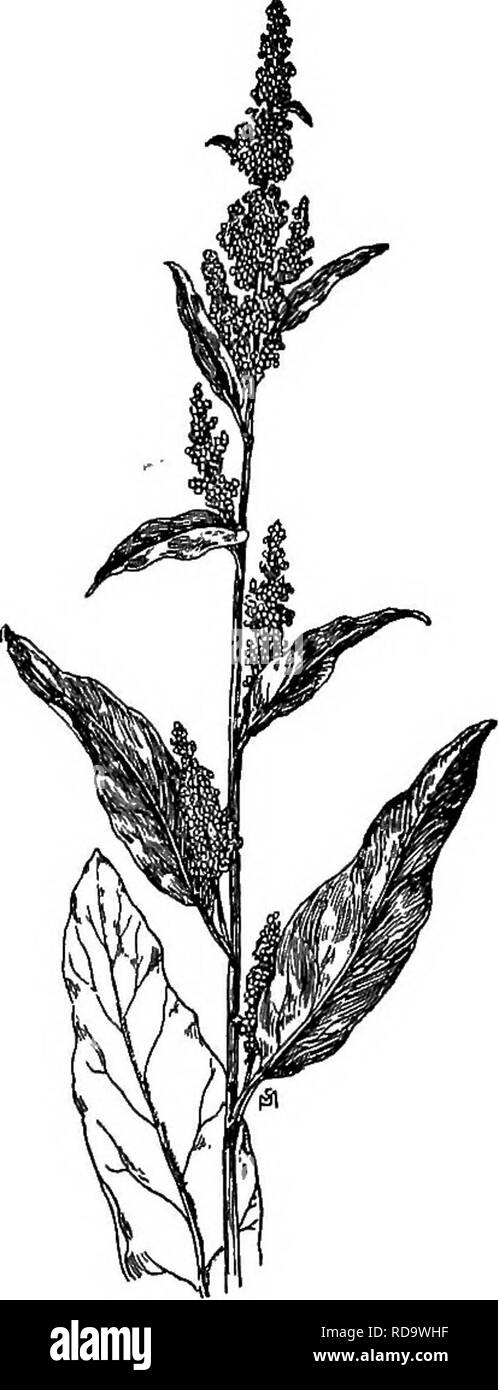. A manual of weeds : with descriptions of all the most pernicious and troublesome plants in the United States and Canada, their habits of growth and distribution, with methods of control . Weeds. POLYGONAGEAE {BUCKWHEAT FAMILY) 91 Range: Newfoundland to Ontario, southward to Pennsylvania, Ohio, and Kansas. Habitat: Rich soil; farmyards, waste places, roadsides. A very large species, with a stout and very deep taproot. Stem sometimes attaining to eight or ten feet in height but usually two to six feet tall, stout, erect, grooved, and smooth, simple or sparingly branched. The large basal leaves

Image details
Contributor:
The Book Worm / Alamy Stock PhotoImage ID:
RD9WHFFile size:
7.2 MB (243.4 KB Compressed download)Releases:
Model - no | Property - noDo I need a release?Dimensions:
979 x 2553 px | 8.3 x 21.6 cm | 3.3 x 8.5 inches | 300dpiMore information:
This image is a public domain image, which means either that copyright has expired in the image or the copyright holder has waived their copyright. Alamy charges you a fee for access to the high resolution copy of the image.
This image could have imperfections as it’s either historical or reportage.
. A manual of weeds : with descriptions of all the most pernicious and troublesome plants in the United States and Canada, their habits of growth and distribution, with methods of control . Weeds. POLYGONAGEAE {BUCKWHEAT FAMILY) 91 Range: Newfoundland to Ontario, southward to Pennsylvania, Ohio, and Kansas. Habitat: Rich soil; farmyards, waste places, roadsides. A very large species, with a stout and very deep taproot. Stem sometimes attaining to eight or ten feet in height but usually two to six feet tall, stout, erect, grooved, and smooth, simple or sparingly branched. The large basal leaves are sometimes more than two feet in length, oblong lance-shaped, broadening above the base, smooth but with thick ribs and veins and long petioles; stem leaves long- pointed and much smaller. Panicle very large and dense, sometimes nearly two feet in length, its branches nearly erect, often with leafy bracts among the whorled flowers. These are small and green with six sepals, six stamens and three styles, the calyx differing from that of the following species in that only one of the three enlarged, heart-shaped, veiny inner sepals or valves has a small tubercle on its back, or sometimes merely a thickening of the base of its midrib. Pedicels slen- der with a swollen joint near the base. Fruit an achene, sharply three-angled, about one-eighth of an inch long, smooth, shining, light brown. (Fig. 52.) Controlled, like the Curled Dock, by deep cutting or grubbing or by hand- -pia. 52. — Patience Dock pulling when the ground is sufficiently soft, (fiwmex Patientia). x^. NARROW-LEAVED DOCK Riimex crispus, L. Other English names: Yellow Dock, Curled Dock. Introduced. Perennial. Propagates by seeds. Time of bloom: June to September.. Please note that these images are extracted from scanned page images that may have been digitally enhanced for readability - coloration and appearance of these illustrations may not perfectly resemble the original work.. Georgia, Ada Eljiva, 1859-1921.